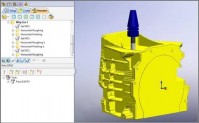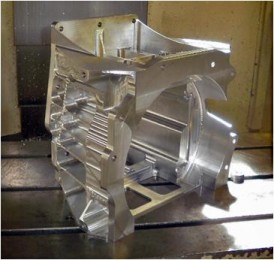When MetalMoro needed a quick change to a custom flange for a race car, they found the answer could be put to work inside their existing SolidWorks.
Submitted article
For over 40 years, MetalMoro in Rio Grande do Sul, Brazil, has been producing competitive automotive racing cars and parts. As a manufacturer of high-performance race cars, go-karts and aftermarket parts, they are a well known brand in key categories of motor racing: Campeonato Gaúcho, Brasileiro de Endurance, Troféu Linea & Championship and Brazilian Kart. In the last decade, MetalMoro’s Sport Protótipo MCR model race car has amassed an impressive list of victories in major championships, even winning the prestigious 12 Hours of Tarumã an impressive seven times. 
Their newest model, the Sport Protótipo MRX model is positioned to continue the successful heritage. The MRX is offered in both turbo and aspirated versions, is characterized by high performance, offers excellent aerodynamics and easy body adjustments.
One of the bigger challenges in the development of the MRX was deciding which engine and transmission combination to use to accomplish the cars high performance goals. They decided on a Ford Cosworth, 4 cylinder, 2.0 liter engine with 410 horsepower, along with a Hewland FTR 6 speed sequential transmission. The engineers at MetalMoro were confident this combination offered the best power to weight ratio. As typically happens however when being a market innovator, MetalMoro’s engineering team quickly came up against a manufacturing challenge.
 “The flange, which is the main housing that connects the engine to the transmission, needed to be longer than normal,” stated Claudio Ferretti Jr., Supervisor of Engineering at MetalMoro. “This required us to come up with a new design in SolidWorks.”
“The flange, which is the main housing that connects the engine to the transmission, needed to be longer than normal,” stated Claudio Ferretti Jr., Supervisor of Engineering at MetalMoro. “This required us to come up with a new design in SolidWorks.”
Once the part was designed, the real challenge was finding a way to accurately and efficiently manufacture the flange on a CNC. “The flange is an extremely complex part and requires many set-ups,” said Ferretti. “Programming the part manually was nearly impossible and required way too much time. In addition to the high manufacturing costs, we had some concerns about accuracy.”
Ask the specialist
To help clear this manufacturing hurdle, MetalMoro contacted MAX3D in São Leopold, their CAD software vendor and a specialist in CAM (computer aided-manufacturing) software. “After evaluating their unique CAM needs with our sales team: ease of use, fast programming time and efficient tool paths, I quickly recommended VisualMILL,” stated Márcio Ribeiro, CAM Technical Specialist at MAX3D. “MetalMoro’s engineering team had standardized on SolidWorks for their product design so I also suggested they use the VisualMILL add-in for SolidWorks.” This solution allowed MetalMoro to create an NC program (to drive the CNC) directly inside SolidWorks, which was a very familiar design environment. And, because VisualMILL directly references the SolidWorks CAD model, it helped ensure the NC program was very accurate.
Within 24 hours of receiving approval from MetalMoro to start the proof of concept process, MAX3D was at MetalMoro’s location testing their flange part on their CNC with VisualMILL. “The proof of concept created some interesting challenges and required several steps: adjusting the post-processor, graphical simulation and machining the test piece to name a few,” said Ribeiro. “This was the first time the part had been produced on a CNC so we were all curious and excited to see the results.” 
The final results: In less than 63 hours from the time MetalMoro first contacted MAX3D, they had an accurate finished part produced on their CNC. The entire process, from programming to output, was completed in a very short period of time and to the complete satisfaction of MetalMoro. “With VisualMILL and MAX3D’s help, we realized our goal of accurately and quickly producing our new flange,” said Ferretti.





